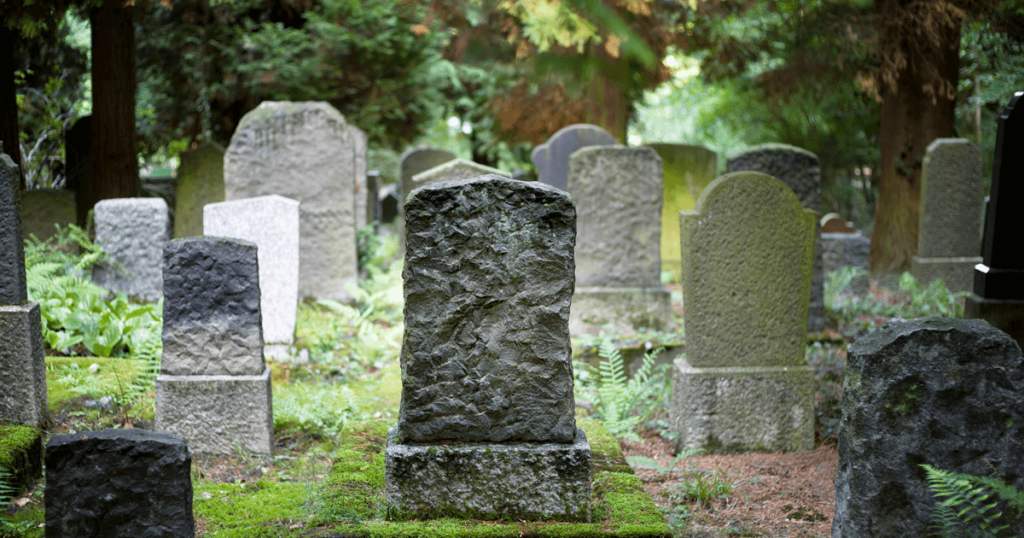

Caitlin Doughty is a mortician, an activist, and the author of From Here to Eternity and Smoke Gets in Your Eyes. As the founder of The Order of the Good Death, she encourages a more positive outlook on dying and alternative death practices. We asked her to pose five questions on the future of burial practices in the United States.
1. Last year, 2016, was the first time that the cremation rate in America topped 50 percent. The National Funeral Directors Association predicts that by 2025, almost 64 percent of Americans who die in that year will be cremated. Cremation is less expensive than conventional burial, but there are drawbacks. It is resource intensive. It adds carbon and other pollutants to the atmosphere. And it typically takes place in harsh, grim, industrial settings not conducive to gatherings of mourners. The green burial movement, however, gives families a chance to connect with nature and fulfill their loved one’s wish to decay peacefully in a wilderness setting. These burials typically feature biodegradable caskets, with trees, wildflowers, and shrubs—not headstones—marking the gravesite. No embalming fluids are used: stewardship of the land is paramount.
Conservation cemeteries, with land permanently set aside for plants and wildlife, are the next level of green burial. Although only a few such cemeteries currently operate in the United States, there are more than 1,300 conservation land trusts, covering 56 million total acres, across the country. Seventy-two percent of that land is owned by trusts allowing public access. Permitting green burials on these lands would raise revenue for their preservation while ensuring the sanctity of the protected spaces, creating even deeper connections between communities and the land. Could big conservation groups join forces with the green burial movement to change the way the dead are buried in America?
2. The history of American burial involves the story of urbanization and the movement away from small cemeteries run by churches and families. But many older cemeteries still exist in one form or another, particularly in the Northeast. An exhaustive WPA survey in the 1930s listed 2,269 cemeteries in Connecticut alone. They demand attention and upkeep but can’t accommodate many new casketed burials. Stephanie Gaines works with the Crestone End-of-Life Project in Colorado, the country’s only public open-air cremation pyre. I borrow this question from her work: Can we repurpose older cemeteries for natural and green burials, and involve local people once again in the preservation of these historic places?
3. A U.S. Supreme Court decision—Dougherty v. Mercantile Safe Deposit and Trust Company in 1978—forbids the disturbing of a “decently buried” body. But for much of Christian history, commoners buried in church graveyards would be disinterred after decay and their bones transferred to ossuaries. These rotating burials continue around Europe today. Plots in many countries are leased for a number of years and can be renewed for an additional fee. Greece, which for religious reasons outlawed cremation until 2006, recently faced a crisis of mass exhumations when family members ran out of cash. But done right, temporary burial serves the needs of a community while costing far less than permanent interment. A 25-year grave plot in Heidelberg, Germany, costs only 2,100 euros. Can Americans be sold on the idea of gravesite rental?
4. Oslo and Tokyo are pioneering the design of new skyscraper cemeteries. Brazil has a 32-story necropolis, the world’s tallest. Israel no longer permits new outdoor graves, and 30 new multitier cemetery buildings are going up across Tel Aviv. Because in Jewish burial a body must rest on soil, these new cemetery towers contain earth-filled pipes that connect to the ground and spread out through each level. But in Norway and elsewhere, the public is largely opposed to the skyscraper cemetery. Would Americans warm to the idea of vertical cemeteries?
5. Even without embalming and sealed coffins, bodies decompose at different speeds. In a typical green burial, a body is covered only in a biodegradable shroud and lowered into the earth. Governments, citing public health concerns, tend to favor deep burials. Advocacy groups have argued for shallower burial depths—like three and a half feet—at which the earth’s powers of decomposition are more active, and nutrients from dead bodies can actually nourish life on the surface. But pushing for any change in funeral practices involves wrangling with a range of entrenched superstitions about the dead body. With the rise of green burial, will we be freer—ethically and legally—to decompose in peace?


